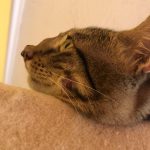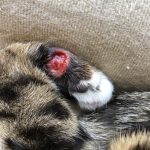hello Amanda!
If you think your kitty has stertor, or what I call upper nasal snoring sounds, I think it is best to start at your vets office. A couple of things are important to discuss early on. One, lots of stertor sounds alike. For the many cases of polyps that I have seen it is important to look at the whole cat, take a very detailed history and do the basics, like ruling out URI (upper respiratory infection) first. Lots of cats get this, as mist have come through rescue/shelter scenarios. So, I always talk to clients about covering the basics first.
URI should look like infection. Lethargy, fever, ocular and nasal discharge are usually present. Antibiotics are our first stop for these cats. I usually use clavamox, doxycycline, or azithromycin (I’ll even try all three before I move out of the infection suspicion scenario).
BUT, some cats are instead chronic rhinitis. These are usually a little older, and a little distanced from the rescuing phase of their lives. They are usually the somewhat older cats (like 2-6 years old) and they were probably exposed to a herpes virus early on. They sort of never get over the snoring and sniffles. These guys are life long snifflers. Usually with some degree of nasal and ocular discharge.
There are also the polyp cats, These are the ones I see often, because, their primary vet doesnt want to go take a look because if they find a polyp they are afraid to remove it. So most of the cats I see are the suspected polyps who cannot afford the $2500 plus estimate the specialists are giving for retroflex endoscopy, and removal with a surgeon.
I know lots of general practitioners who will sedate (yes this is required to get an adequate look) who will look and will remove but the risks are important to discuss before hand. The risks are; regrowth. I have seen it happen in two cases. Both resolved permanently after the second removal. I have also seen significant bleeding after removal. The cat ultimately did fine, but, I was worried for a few days.
If you find yourself with a vet who is reluctant to look ask for a referral. If the referral is to a specialisit and this is not affordable call the local cat specialty clinics, rescues and shelters for a referral you can afford.
I hope this helps. Please let me know what happens.. If you cannot find help let me know and I can reach out to some of the rescue people I know in AZ.
good luck!
krista


















Hello,
I am so sorry to hear of your frustration over your cats case.
I am not able to give much advice on this case with specific details to treatment but I will add that I think seeing a feline practitioner (someone who just sees cats) and see if they can help.
I am sorry but I cannot advise a homeopathic vet on this case, it is too far advanced.
I wish you the best of luck
Thank you, Dr. Magnifico,
I have agreed to up her dose to 150 mg of fluconazole and it’s been a week with no improvements so far – except I noticed her drinking more water. Living on a small island, we don’t have any feline only vets, every vet here sees both cats and dogs. I really don’t want to elect euthanasia (which the vet said is an option) and the other end of the spectrum is my fear that she will suffocate eventually. It’s been so painful watching this unfold. Thank you for responding, about homeopathy. It is an added cost and couriers to get the medicine in. I have been desperate.
Hello,
I’m so sorry to hear that your cat is so unwell. I’ve luckily never seen ryptococcosis, but if it is treated with itraconazole or fluconazole, maybe ketaconazole is an option to try, too?
Thank you for trying so much for your cat and not giving up on her. You are both amazing.
Shiria
Hello Shiria, thank you for your kind comment. Petra is amazingly resilient.
Animals take on suffering without complaint so I don’t know if I’m doing the right thing at this point, if she won’t get better. I’ve read about ketoconazole but it seems like the least helpful of the two azoles for this condition, and it seems like it has more adverse effects too. I will look into it, though, I don’t know if I’m doing the right thing for her as she struggles to breathe and trials take time. It hurts to think of putting her down and it hurts to see her suffering without knowing what will help, or if anything will. At a certain point I ask if it’s selfish to keep her alive & suffering in the hopes something will help, over a year on.
Hello. An update for anyone in the future researching on behalf of their pet who develops this fungus.
A cure is possible, some cats respond very well to anti-fungal meds. My Petra did not. Initially, her nose cleared up very well and she could breathe much better, but the fungus returned with a vengeance a few months later.
She has been on Fluconazole for 11 months total:
(37.5mg – 75mg), and on 150mg for 3 months. 2 months into the higher dose, I found her with anisocoria (one pupil very dilated). It went away and came back over two days. One of her eyes is droopy (Horner’s syndrome). Yesterday I found blood smeared on her paw and couldn’t find a wound.
I took her to the vet, who opened her mouth and discovered the fungal growths are pushing through her soft palate (roof of mouth) and causing anatomical separation. Her nose is swelling up considerably and distorting again. It began regressing 6 months ago but was relatively stable, but now it’s increasing in size and doubling almost overnight. She has lost 1 kilo. The vet has recommended euthanasia, unequivocally. Petra is struggling to get air in, and while we hoped for a cure (with medication) that is not happening. It’s cruel to continue with no hope of quality of life and only more suffering, and the outcome if left would be suffocation.
We have decided to let my sweet girl go, while she is still mobile, eating, before she suffocates to death.
It’s been so traumatic, to witness this and I want to send good vibes to anyone in the future who is struggling with the same disease (mainly the nose – which causes so much suffering).